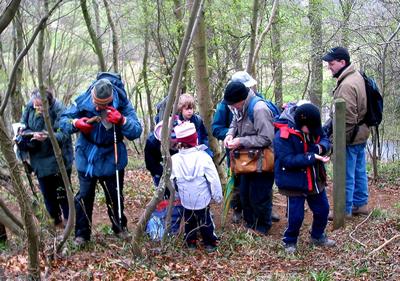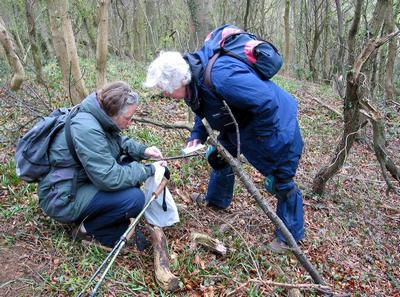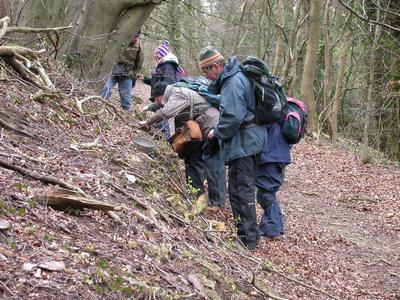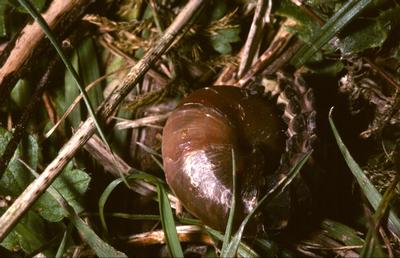 |
 |
| Mollusc hunting on Broadway Hill © Ron Boyce | |
Worcestershire Record No. 25 November 2008 pp. 18-19
Conchological Society of Great Britain & Ireland.
Field meetings 5th April and 14th June 2008.
Harry Green
(This article is an edited version of one written for Mollusc World, the Conchological Society’s newsletter and magazine)
A small part of the south-eastern corner of Worcestershire (VC37) extends up the Cotswold escarpment and includes a small area above Broadway. Here the hill is capped by oolitic limestone typical of the Cotswolds – the only similar Worcestershire geology is found a few miles to the west where the Cotswold outlier of Bredon Hill rises above the Vale of Evesham. Following on from a series of visits in recent years to many parts of Worcestershire, recording mainly terrestrial molluscs, we felt we should not neglect our small patch of the Cotswolds so a field meeting was planned for Saturday 5th April 2008. Around 15 people (Society members and local naturalists, including three sharp-eyed children) met in the Car park at the top of Fish hill – originally a tiny fragment of Gloucestershire (VC33) purchased by Worcestershire some years ago to provide a car park giving access to a footpath network. We decided to examine the woodland to the north in the morning and grassland to the south in the afternoon. However, the unplanned part of the day was a biting northerly wind which, following warm days, took us all by surprise and very few of us were fully insulated against temperatures just above freezing and the arctic blast! Add to this cold rain at lunchtime and we had all had more than enough and retired hurt, surely a retreat unparalleled in the history of snail recording! The idea of searching exposed grassland in such conditions had little charm and we decided to visit those areas later in the summer.
 |
 |
| Mollusc hunting on Broadway Hill © Ron Boyce | |
So, on 5th of April we visited the woodland. This is mainly of ash and beech and lies just below the top of the escarpment on the Worcestershire side of the county boundary. In the wood there is plenty of evidence of old quarrying. Beneath the trees is a thin herbaceous and scrub layer in deep shade, with leaf litter of varying depth, and patches of exposed stone and walling. Despite chilled fingers a reasonable list of snails was compiled with relatively few slugs probably because of preceeding dry conditions. Sharp-eyed children also found Cream-spotted Ladybird Calvia 14-guttata and Orange ladybird Halyzia 16-guttata hibernating in the litter, the latter in a beech mast husk, together with a few millipedes, harvestman and the centipede Lithobius variegatus which is usually an indicator of undisturbed woodland habitats.
Following the April retreat we arranged a second visit to Broadway Hill on 14th June 2008. The weather was fine, warm and with wonderful views over Worcestershire to the west! Fewer people could attend this meeting so only seven of us gathered in the car park. This time we headed south and first visited a small old quarry over-grown with beech trees and bordered by a typical Cotswold dry stone wall. This small place kept us interested for an hour and more and produced a good list of molluscs including the classic dry-stone wall species Pyramidula rupestris. An interesting non-mollusc find was a flatworm Microplana scharfi under decaying wood.
 |
 |
| Mollusc hunting on Broadway Hill © Harry Green | Glow-worm larva attacking trichia striolata © Ron Boyce |
We then followed the old road past the building which once housed the famous Fish Inn originally set on the side of the main Oxford to Worcester road but now a private dwelling down in a cul-del-sac separated from the new course of the main rod. The verges contained numerous Monacha cantiana and flowers attracted a variety of bumblebees and hoverflies. Further along and the path led through woodland to open grazed limestone grassland eroded on steep banks by sheep to expose the soils and small screes of oolitic limestone. This woodland was relatively unproductive for molluscs partly because we moved through it quickly to spend more time on the grasslands beyond. These are floristically rich and at the time of our visit the sward was quite tall and un-grazed. Ron collected several samples from the grassland and scree with his small vacuum sampler which added some tiny snails to the records. Arion fasciatus was found under a solitary large lying log and I was very pleased to find a few empty shells of Ceciliodes acicula conveniently exposed by sheep action. It was also a good day for other invertebrates and naturalist John Meiklejohn obtained useful records of Coleoptera and Hemiptera from a somewhat under-recorded part of Worcestershire. A good selection of solitary bees were found and passed on to the county recorder – there are even fewer records for this group. Towards the end of the visit several members of the group found a glow-worm eating a Trichia striolatus while I was somewhere else and much to my disappointment I didn’t see it and I don’t think we have any pictures! [Actually Ron Boyce had taken pictures]. All in all this was a good day in the sunshine which compensated for the miserable April visit.
Recorders were Rosemary Hill, Ron Boyce, John Meiklejohn, David Long, Terry Knight, Harry Green, Gary Farmer and family, Joy Ricketts and Ruben Poloni.
| WBRC Home | Worcs Record Listing by Issue | Worcs Record Listing by Subject |